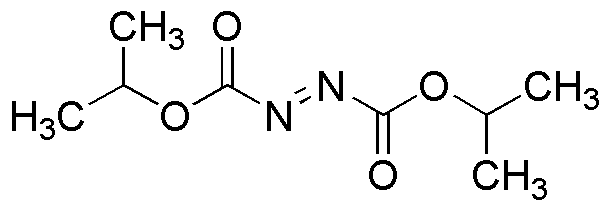Diisopropyl azodicarboxylate is widely utilized in research focused on:
- Organic Synthesis: This compound serves as a versatile reagent in organic chemistry, particularly in the synthesis of various nitrogen-containing compounds, enabling researchers to create complex molecules efficiently.
- Polymer Chemistry: It is employed as a chain transfer agent in the production of polymers, allowing for better control over molecular weight and polymer architecture, which is essential for developing high-performance materials.
- Pharmaceutical Development: In the pharmaceutical industry, it is used in the synthesis of active pharmaceutical ingredients (APIs), facilitating the creation of new drugs with improved efficacy and safety profiles.
- Bioconjugation: This compound is useful in bioconjugation processes, where it helps link biomolecules to other molecules, enhancing the development of targeted drug delivery systems and diagnostics.
- Research on Reactive Intermediates: It aids researchers in studying reactive intermediates in chemical reactions, providing insights into reaction mechanisms and helping to optimize conditions for desired outcomes.
General Information
Properties
Safety and Regulations
Applications
Diisopropyl azodicarboxylate is widely utilized in research focused on:
- Organic Synthesis: This compound serves as a versatile reagent in organic chemistry, particularly in the synthesis of various nitrogen-containing compounds, enabling researchers to create complex molecules efficiently.
- Polymer Chemistry: It is employed as a chain transfer agent in the production of polymers, allowing for better control over molecular weight and polymer architecture, which is essential for developing high-performance materials.
- Pharmaceutical Development: In the pharmaceutical industry, it is used in the synthesis of active pharmaceutical ingredients (APIs), facilitating the creation of new drugs with improved efficacy and safety profiles.
- Bioconjugation: This compound is useful in bioconjugation processes, where it helps link biomolecules to other molecules, enhancing the development of targeted drug delivery systems and diagnostics.
- Research on Reactive Intermediates: It aids researchers in studying reactive intermediates in chemical reactions, providing insights into reaction mechanisms and helping to optimize conditions for desired outcomes.
Documents
Safety Data Sheets (SDS)
The SDS provides comprehensive safety information on handling, storage, and disposal of the product.
Product Specification (PS)
The PS provides a comprehensive breakdown of the product’s properties, including chemical composition, physical state, purity, and storage requirements. It also details acceptable quality ranges and the product's intended applications.
Certificates of Analysis (COA)
Search for Certificates of Analysis (COA) by entering the products Lot Number. Lot and Batch Numbers can be found on a product’s label following the words ‘Lot’ or ‘Batch’.
*Catalog Number
*Lot Number
Certificates Of Origin (COO)
This COO confirms the country where the product was manufactured, and also details the materials and components used in it and whether it is derived from natural, synthetic, or other specific sources. This certificate may be required for customs, trade, and regulatory compliance.
*Catalog Number
*Lot Number
Safety Data Sheets (SDS)
The SDS provides comprehensive safety information on handling, storage, and disposal of the product.
DownloadProduct Specification (PS)
The PS provides a comprehensive breakdown of the product’s properties, including chemical composition, physical state, purity, and storage requirements. It also details acceptable quality ranges and the product's intended applications.
DownloadCertificates of Analysis (COA)
Search for Certificates of Analysis (COA) by entering the products Lot Number. Lot and Batch Numbers can be found on a product’s label following the words ‘Lot’ or ‘Batch’.
*Catalog Number
*Lot Number
Certificates Of Origin (COO)
This COO confirms the country where the product was manufactured, and also details the materials and components used in it and whether it is derived from natural, synthetic, or other specific sources. This certificate may be required for customs, trade, and regulatory compliance.

